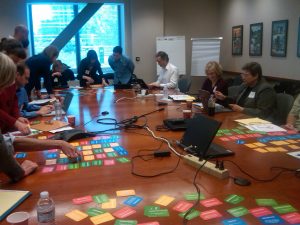Project management and transformational change
Last week, I had the opportunity to participate in a day-long workshop to orient 3 new task force teams. In this context, a “task force team” is a 6-7 person team of experts drawn from different University of California (UC) campuses and California Digital Library (CDL). These teams are each concerned with one aspect of we are calling “Next Generation Technical Services” (NGTS). A first group uncovered a set of issues in its reports (http://libraries.universityofcalifornia.edu/about/uls/ngts/docs/ngts_phase1.html), and these have led to the creation of new focused task forces for a second deeper dive (http://libraries.universityofcalifornia.edu/about/uls/ngts/docs/ngts_phase2.html). The impressive call to action for this second phase is that the new teams must engage in transformational thinking. Each team is charged with looking for new business models in their specific areas which are: Financial Infrastruction, Enterprise-Level Collections Management Services, and New Modes for Organizing and Providing Access to Special Collections, Archives, and Digital Formats. And, each team must reach for the innovative idea given the current resource constraints.

To prepare the teams for the work ahead and to give them an orientation to transformational thinking, the senior executives overseeing the NGTS initiative asked Katharine Mitchell, an Internal Organization Development Consultant, from the Center for Organizational and Workforce Effectiveness (http://hrweb.berkeley.edu/corwe.htm) (COrWE) at UC Berkeley, to facilitate the primary discussions.
Mitchell led everyone through a series of exercises using the “Whole Brain Model (http://www.ucop.edu/ucophome/businit/boi/presentations/2005/05styles.pdf),” suggesting that what the team members would learn about each would “lay the groundwork for effective work as virtual teams.”
Turning to the transformational change topic, Mitchell had given as preparatory reading the very interesting “Awake at the Wheel: Moving Beyond Change Management to Conscious Change Leadership.” (http://www.beingfirst.com/resources/pdf/AR_PDF_AwakeAtTheWheel_v2_091123.pdf) This article argues that, when environmental forces have changed dramatically, you have to abandon mere change management and move to transformational thinking, a “fundamental shift in mindset, organizing principles, behavior, and/or culture, as well as organizational changes, all designed to support new business directions.” Mitchell led a conversation about what is and isn’t transformational change, as opposed to merely developmental or transitional change. One person remarked “Maybe transformational change can’t be managed.”
After lunch, it was my turn to provide these teams with a quick overview of project management. I said, when you are heading into the unknown, you may not be able to manage every aspect, but you can provide some markers for yourself. You can keep a record of what you have done, and you can communicate with your sponsor in order to ask for help when needed.
I have been under the gun more times than once, and I had thought about what the minimal requirements for tracking status, avoiding pitfalls, and staying in touch would be. They have to hit the ground running, as their progress reports are due by the end of July. So, I recommended 4 simple steps. (I should note that each team was launched with an official Charge document that could hold the place of a scope/charter.)
- Create task list, with target dates (establish rhythm, identify obstacles, divide up work)
- Identify obstacles (What has medium to high likelihood of delaying your ability to succeed? What can you do in response, if it comes to pass?)
- Establish rhythm (communication, document sharing, issue & action item tracking)
- Put it into action! (At each meeting, have a brief check-in on your task list. Where are we?)
I gave them an example (high level) task list and a suggested approach to reporting for their interim and progress reports.
My hope was to hit that sweet spot: enough structure to hold their work and help them forward but not too much bulk that it weighs them down and holds them back from the nimble, exciting, scary, inventive, unruly, transformational work they need to do.
I’m not sure that I hit the spot, but a very short amount of time will tell. What would you have told them? What is your list of essential steps?
